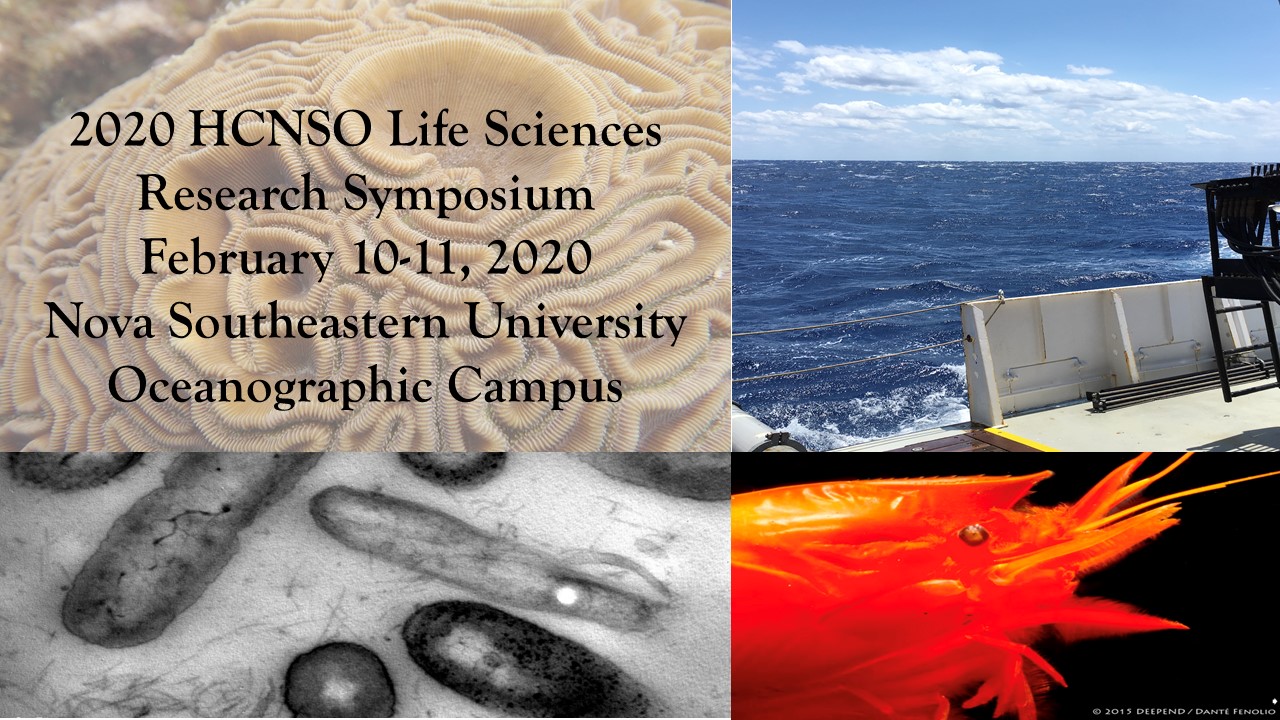On the age and growth of mesopelagic fishes, with case studies of four ecologically important species from the Gulf of Mexico
Location
HCNSO Guy Harvey Oceanographic Center Nova Southeastern University
Start
2-11-2020 1:45 PM
End
2-11-2020 2:00 PM
Type of Presentation
Oral Presentation
Abstract
Mesopelagic fishes provide important ecosystem services, such as carbon sequestration via the biological pump and provision of food for economically important (billfishes and tuna) and federally protected (cetaceans and seabirds) species. These attributes are becoming increasingly recognized, while simultaneously mesopelagic fisheries are becoming of interest as coastal fisheries have become overexploited. Additionally, climate change, ocean acidification, and seabed mining threaten deep-sea fishes. With increasing interest in deep-sea fisheries and anthropogenic threats, age and growth information on these fishes is a necessity for management. A serious constraint for conservation and management of these resources is that very few age estimations of mesopelagic fishes have been validated. In order to address information gaps, age estimations and microincrement descriptions linked to life histories will be presented for the meso/bathypelagic fish species Lampanyctus lineatus (lanternfish), Omosudis lowii (hammerjaw), Stomias affinis (dragonfish), and Chauliodus sloani (viperfish). These fishes were collected during seven research cruises from 2010 – 2011, as part of the DWHOS NRDA, and during six research cruises from 2015 – 2018, as part of the GOMRI-supported DEEPEND Consortium. We found that Stomias affinis grow exponentially, with a slow initial growth followed by a rapid increase in growth with time. Chauliodus sloani exhibits logistic growth, with a gradual increase in growth at first followed by period of rapid growth and then a decrease in growth. Omosudis lowii and Lampanyctus lineatus grow isometrically, which is the normal growth pattern for most fishes. These are the first growth curves produced of these species for the Gulf of Mexico, which serves as an analog for the world’s low-latitude, oligotrophic domain.
On the age and growth of mesopelagic fishes, with case studies of four ecologically important species from the Gulf of Mexico
HCNSO Guy Harvey Oceanographic Center Nova Southeastern University
Mesopelagic fishes provide important ecosystem services, such as carbon sequestration via the biological pump and provision of food for economically important (billfishes and tuna) and federally protected (cetaceans and seabirds) species. These attributes are becoming increasingly recognized, while simultaneously mesopelagic fisheries are becoming of interest as coastal fisheries have become overexploited. Additionally, climate change, ocean acidification, and seabed mining threaten deep-sea fishes. With increasing interest in deep-sea fisheries and anthropogenic threats, age and growth information on these fishes is a necessity for management. A serious constraint for conservation and management of these resources is that very few age estimations of mesopelagic fishes have been validated. In order to address information gaps, age estimations and microincrement descriptions linked to life histories will be presented for the meso/bathypelagic fish species Lampanyctus lineatus (lanternfish), Omosudis lowii (hammerjaw), Stomias affinis (dragonfish), and Chauliodus sloani (viperfish). These fishes were collected during seven research cruises from 2010 – 2011, as part of the DWHOS NRDA, and during six research cruises from 2015 – 2018, as part of the GOMRI-supported DEEPEND Consortium. We found that Stomias affinis grow exponentially, with a slow initial growth followed by a rapid increase in growth with time. Chauliodus sloani exhibits logistic growth, with a gradual increase in growth at first followed by period of rapid growth and then a decrease in growth. Omosudis lowii and Lampanyctus lineatus grow isometrically, which is the normal growth pattern for most fishes. These are the first growth curves produced of these species for the Gulf of Mexico, which serves as an analog for the world’s low-latitude, oligotrophic domain.


